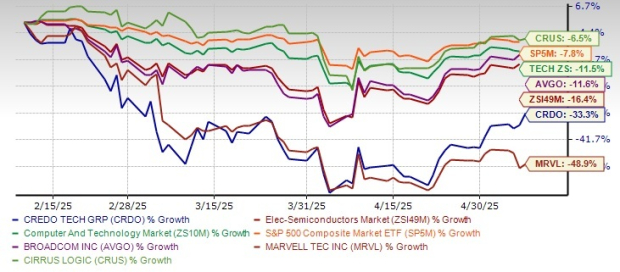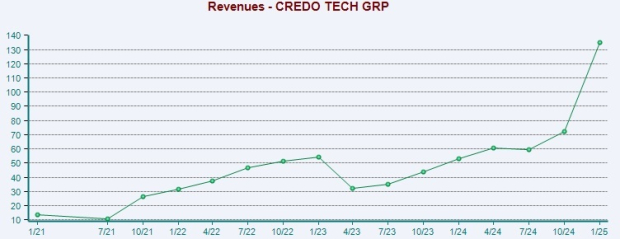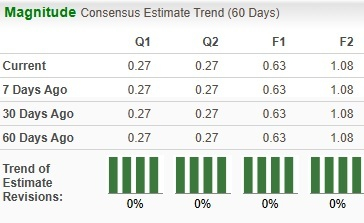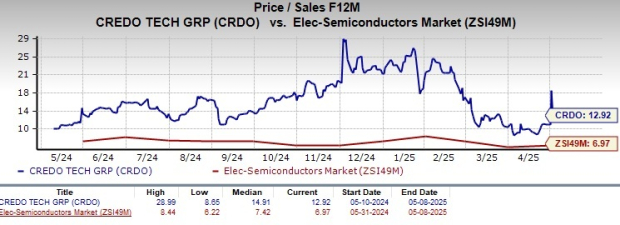|
|
|

|
|||||

|
|
Credo Technology Group Holding Ltd CRDO stock has slipped 33.3% over the past three months, significantly more than the Electronic-Semiconductors industry’s decline of 16.4%. The broader Computer and Technology sector and S&P 500 Composite have registered declines of 11.5% and 7.8%, respectively, over the same time frame. The markets since April have been affected by evolving U.S. trade policy and diminishing macroeconomic visibility.

CRDO gained 6.1% yesterday and closed trading at $51.39, but the stock is down 41% below its 52-week high of $86.69. This is likely to spook investors as they contemplate how to strategize their investment now. The natural question is: Should you stay invested or exit now?
Let’s weigh the pros and cons of this AI stock and see whether it is worth staying invested or not.
Credo is a provider of high-performance serial connectivity solutions for the data infrastructure market. Amid exponential data growth and rapid AI proliferation, market demand for faster and energy-efficient connectivity solutions continues to increase. This bodes well for Credo.
One of Credo’s key strengths lies in its Active Electrical Cables (AEC) product line, which posted triple-digit sequential growth in the third quarter of fiscal 2025. The growth is driven by its increasing adoption in the data center market. The demand for AECs is increasing as ZeroFlap AECs offer more than 100 times improved reliability than laser-based optical solutions. This made AECs an increasingly attractive option for data center applications, contributing to the new expansion of AEC usage and further solidifying Credo Technology’s position in the market.

Credo is also focused on expanding its product portfolio to include a portfolio of PCIe solutions, which will address the growing demand for AI scale-out and scale-up networks. The company expects the PCIe products to considerably expand its total addressable market. This expansion into PCIe connectivity further solidifies the company's competitive positioning in the high-performance computing and AI markets.
Momentum in the optical business, particularly for Optical Digital Signal Processors (DSPs), bodes well. In April 2025, CRDO unveiled the innovative Lark Optical DSP family, engineered to transform 800G optical transceivers. The Lark portfolio has two distinct optical DSP products. The Lark 800 is a high-performance, low-power DSP optimized for fully retimed 800G transceivers, designed to meet the stringent power and cooling requirements of hyperscale AI data centers. The Lark 850 is an ultra-low-power 800G Linear Receive Optics DSP, consuming under 10W, making it an ideal solution for AI-driven data environments where power efficiency is exceptional.
CRDO’s PCIe retimers and Ethernet retimers saw strong customer interest, especially for scale-out networks in AI servers. This growing demand underscores the increasing importance of high-performance solutions in the rapidly expanding AI server market. PCIe retimer demand is expected to exceed $1 billion by 2027, positioning Credo Technology for significant future revenue growth.
For the fourth quarter of fiscal 2025, CRDO expects revenues between $155 million and $165 million. The Zacks Consensus Estimate for fiscal fourth-quarter revenues is pegged at $160 million, suggesting growth of 163.2% from the year-ago quarter’s reported figure.
For the third quarter of fiscal 2025, CRDO reported $135 million in revenues, up 87% sequentially and 154% year over year, beating the Zacks Consensus Estimate by 12.5%. This surge was mainly driven by its largest hyperscale customer, which significantly scaled the production of AI platforms, reflecting the growing demand for AI-powered connectivity solutions.
Despite Credo’s strong performance and innovative solutions, several challenges pose headwinds to its prospects. CRDO’s business is heavily tilted toward AI-related infrastructure and the hyperscale cloud market spending. While these segments are currently experiencing high growth, they are also cyclically dependent on AI capex spending, which could decelerate after initial buildouts.
Credo’s non-GAAP operating expenses in the fiscal third quarter surged 16% sequentially to $43.8 million, primarily due to higher headcount. Increasing costs could become a problem if the revenue growth does not keep pace.
In the last reported quarter, 86% of revenue came from a single end customer. This intense customer concentration risk can impact revenues as the company becomes highly vulnerable to the loss of business from those clients. To diversify its base, CRDO added that it has two additional hyperscalers in qualification and has already achieved volume production with three others. The company expects to ramp up with these two hyperscalers in fiscal 2026.
These factors, along with increasing market competition and macroeconomic uncertainties, may impact CRDO’s growth trajectory. Credo competes with semiconductor giants like Broadcom Inc. AVGO and Marvell Technology, Inc. MRVL.
Analysts also seem wary as reflected in unchanged revisions for earnings estimates in the past 60 days.

CRDO’s 33.3% decline is also much steeper than peers like Broadcom and Cirrus Logic, Inc. CRUS. Broadcom and Cirrus Logic have declined 11.6% and 6.5%, respectively. However, Marvell’s stock has declined 48.9% in the same time frame.
Credo Technology stock is also not so cheap, as its Value Style Score of F suggests a stretched valuation at this moment. In terms of the forward 12-month Price/Sales ratio, CRDO is trading at 12.92, higher than the Electronic-Semiconductors sector’s multiple of 6.97.

In comparison, Broadcom trades at a forward 12-month P/S multiple of 14.46, while Cirrus Logic and Marvell Technology are trading at a multiple of 2.76 and 5.71, respectively.
While Credo appears well-positioned in the AI-driven connectivity space, there are several factors that could exert downward pressure on the stock. Key concerns include customer concentration, competitive pressures, stretched valuation, and overreliance on AI spending.
CRDO currently carries a Zacks Rank #3 (Hold), which indicates that investors should wait for a better entry point. However, existing investors can hold the stock as its growth prospects remain intact.
You can see the complete list of today’s Zacks #1 Rank (Strong Buy) stocks here.
Want the latest recommendations from Zacks Investment Research? Today, you can download 7 Best Stocks for the Next 30 Days. Click to get this free report
This article originally published on Zacks Investment Research (zacks.com).
| Dec-21 | |
| Dec-21 | |
| Dec-21 | |
| Dec-21 | |
| Dec-21 | |
| Dec-21 | |
| Dec-21 | |
| Dec-21 | |
| Dec-21 | |
| Dec-21 | |
| Dec-21 | |
| Dec-21 | |
| Dec-21 | |
| Dec-21 | |
| Dec-21 |
Join thousands of traders who make more informed decisions with our premium features. Real-time quotes, advanced visualizations, backtesting, and much more.
Learn more about FINVIZ*Elite